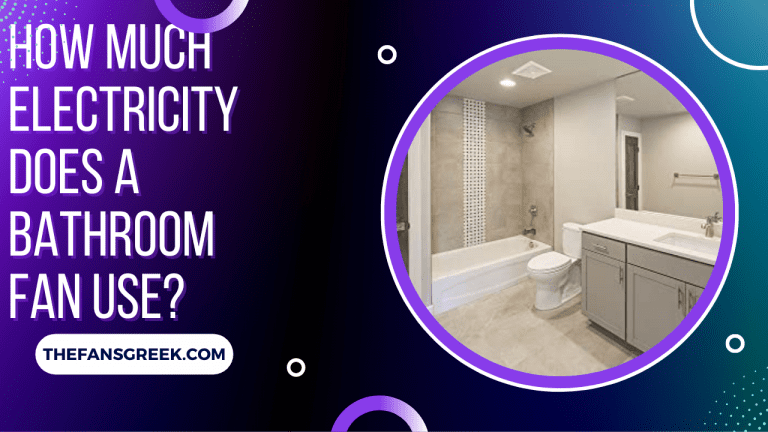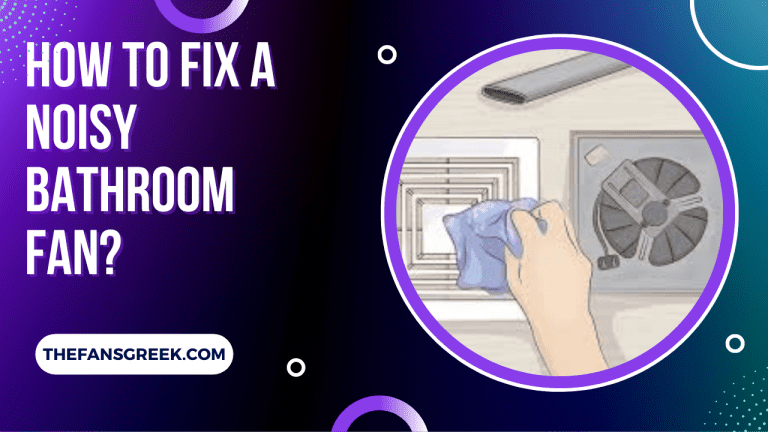How Much Electricity Does A Bathroom Fan Use?
Among the most convenient home appliances is an exhaust fan for the bathroom.
Besides preventing mold growth in your bathroom, this device also eliminates foggy mirror syndrome, reduces airborne contaminants, and keeps unpleasant odors at bay.
In order to accomplish all of this, a bathroom exhaust fan needs electricity.

You’ve come to the right place if you’re wondering how much electricity a typical appliance of this type uses.
The purpose of this article is to explain how a homeowner can calculate the annual cost of using a bathroom exhaust fan and how these appliances get the Energy Star label.
The Introduction
Watts are used to measure the amount of electricity consumed by such a device.
The wattage of a machine indicates its operating power, as you probably already know.
The cost of operating a bathroom exhaust fan with a higher wattage will always be higher.
As a general rule, bathroom exhaust fans range in wattage from 10 to 100.
It is possible, however, for an appliance of this type to have an integrated heater with a total wattage of 1400.
What About Continous Use?
Homeowners must keep in mind that these devices are not designed to be used continuously, that is, 24 hours a day.
Be sure to turn off the bathroom exhaust fan if you aren’t using it. Nevertheless, you should let the device run for at least 20 minutes after taking a shower.
It should be able to completely remove the excess humidity from the bathroom as a result.
Many modern bathroom exhaust fans come equipped with energy-saving features, which is a great advantage.
In addition to humidifiers, there are motion sensors and countdown timers available for bathroom fans.
Electricity bills can be reduced quite a bit by using a fan that turns off by itself after removing moisture.
How Do I Determine the Electricity Cost of a Bath Fan?
You can calculate how much it would cost to run a bathroom exhaust fan continuously for a whole year using a fairly simple calculation.
You must first determine the wattage of your appliance at its maximum operating speed.
The maximum wattage can also be added if your model has a heater or similar features.
Once you’ve done that, you’ll have to divide the number by 1000. In this way, you will convert watts (W) into kilowatts (kW).
Step #1 – Wattage of a Bathroom Exhaust Fan / 1000 = kW (kilowatts)
Divide 70 CFM by 1000, for example, if you have a typical 70 CFM bathroom exhaust fan.
In this case, you’ll get 0.070 kW – the kilowatts.
Then multiply this number by the cost per kWh (kilowatt-hour) in your area.
In the United States, electricity costs about 10 cents per kilowatt-hour, or $0.10 per kWh.
Step #2 – $0.10 kWh x Bathroom Exhaust Fan Kilowatts = The kWh Cost
For a 70 CFM model, multiply its 0.070 kilowatts (kW) by the average kilowatt-hour cost ($0.10) and you get $0.007 kWh.
Since there are 8760 hours in a year, you must multiply this number by the kilowatt-hour cost.
Therefore, $61.32 per year is earned by multiplying 8760 hours by $0.007 kWh.
Step #3 – 8760 Hours x Bathroom Exhaust Fan kWh Cost = Yearly Cost
By using this calculation, you’ll get the amount of money you’d spend if your bathroom exhaust fan ran continuously for one entire year. As a matter of fact, this rarely happens.
By multiplying the number of hours your bathroom exhaust fan is operational by 365, you can get a more realistic result.
How Much Electricity Is Used by the Popular Bathroom Exhaust Fans?
The following table shows how much electricity some of the most popular appliances in this category consume:
| Bathroom Exhaust Fan | CFM Rating | Max Watts | Yearly Cost |
| Delta BreezGreenBuilder | 80 CFM | 14-watts | $12.26 |
| BV Ultra-Quiet | 90 CFM | 24-watts | $21.02 |
| Delta BreezSignature | 130 CFM | 19-watts | $16.64 |
| Panasonic WhisperFit | 110 CFM | 27-watts | $23.65 |
| Broan Nu-Tone 688 | 50 CFM | 108-watts | $43.80 |
| Panasonic WhisperWarm | 110 CFM + Heater | 1430-watts | $1252.68 |
How Do Bathroom Exhaust Fans get an Energy Star Certification?
Under the direction of the U.S. EPA, the Energy Star program verifies whether an appliance is energy-efficient.
There are a few important requirements a bathroom exhaust fan must meet in order to earn an Energy Star rating.
One of the most important requirements is that the appliance must have a base efficiency rating.
It represents the unit’s power consumption/efficiency rating – the number of CFM per watt.
You can obtain your fan’s efficacy rating by dividing the fan’s CFM rating by its maximum wattage.
Your bathroom exhaust fan will be more efficient if the number is higher.
It’s also a good idea to familiarize yourself with bathroom fan noise ratings, even though noise level does not affect electricity usage.
The Minimum Efficacy Rating Required for an Energy Star Rating
There is a minimum efficacy rating of 1.4 for bathroom exhaust fans with CFM ratings between 10 and 89.
The minimum efficacy rating is 2.8 for models with CFM ratings between 90 and 500.
The Takeaway
So, there you have it – a simple calculation to calculate your bathroom exhaust fan’s annual cost.
In my example, I multiplied my fan’s kilowatt-hour cost ($0.007 kWh) by the number of hours in a day your bathroom exhaust fan will be operating ($0.007 kWh), since you probably won’t be running it 24/7 throughout the entire year.



![My Bathroom Fan Won’t Turn Off [FIXED]](https://www.thefansgreeks.com/wp-content/uploads/2022/08/My-Bathroom-Fan-Wont-Turn-Off-768x432.png)
![Bathroom Fan Stopped Working (Won’t Turn On) [FIXED]](https://www.thefansgreeks.com/wp-content/uploads/2022/08/Bathroom-Fan-Stopped-Working-Wont-Turn-On-FIXED-768x432.png)
